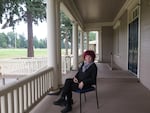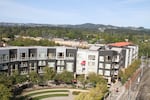The Northwest’s intense growth spurt has repercussions for how we experience the arts — or whether we have a place to experience them at all.

Karen Madsen chairs the board of Arts of Clark County, a volunteer group aiming to facilitate new conversations about arts venues in Vancouver and surrounding areas.
April Baer / OPB
A few years ago, Karen Madsen took ceramics classes in southwest Portland. It wasn’t a big deal to drive from her place in Vancouver.
“I used to go to Multnomah Arts Center,” she said. “I would spend three, four, five hours working there, get on the freeway, and be home in 25 minutes.”
That was before the population boom packed Interstate 5 to capacity.
“It’s now at least a two-hour drive,” Madsen said.
Madsen sat with me on the shady porch of the old Army barracks at Fort Vancouver. Behind us: thousands of square feet of recently renovated historic real estate, including an auditorium — tantalizingly empty. The group Madsen chairs, Arts of Clark County, is hosting a summit meeting here next weekend (Sept. 23) to talk about new creative space: performance venues, new spaces to make and show art, and re-development of old spaces with arts in mind. She said it’s meant to build on a conversation at a 2012 meeting.
“Vancouver, Clark County, had been drive-through.” At that point, Madsen said, it was about building identity. Now, the hope is that artists and arts groups can move forward and lay claim to evolving spaces.
Related: Vancouver Building Boom Begins To Take Shape
Development is happening everywhere. The National Parks Service has signaled it’s ready to make deals to bring arts groups into the barracks. Waterfront Vancouver is developing commercial real estate along the Columbia. The Port has a master plan specifically proposing new art space on its Terminal 1 rebuild.
But all this arts space isn’t free.
Kris Tucker spent 15 years as Washington’s top arts administrator, and now chairs Olympia’s Artspace Alliance. She’s the moderator for next week’s summit. She pointed out “ticket price typically supports only 50 percent of the costs of an arts event. So that other $50 [comes] from where? Maybe the public sector, the city, the county, the state can support the balance, but a lot of the funding for successful arts facilities needs to come from local sources.”
That’s foundations, businesses, and individuals regularly writing checks for operating money to keep doors open and the lights on. Tucker says advocates have to build those relationships now.
Of course, she adds, there’s no substitute for having people in your local government dedicated to the arts.
That’s how it played out down south in Beaverton.

The city's new multi-disciplinary arts center will take shape just behind this bustling complex and plaza. Plans call for a new parking structure directly west.
April Baer / OPB
Washington County’s economic center has several great public spaces, like the plaza flanked by swanky condos outside City Hall. People stop in for lunch or coffee at cafes before stepping on and off the MAX trains. But to this point, this diverse, bustling city has had no arts center.
After years of discussion, Beaverton is on the edge of an $11 million capital campaign to build a center for the arts, with a 450-seat theater, classrooms, a gallery, a rooftop terrace for events and more, on a parcel of land just a few steps from the MAX line.
Beaverton Mayor Denny Doyle has been trying to get something like this off the ground since the early '90s. And now, he said, “Things are happening. We’re going to go hot and heavy really soon. We’ve applied for a couple of grants. We’ve got business support, Nike is with us and Intel. We think we can break ground in 2019.”
He said the arts have been, and will continue to be, an important sphere for the city's diverse people to find common ground.
The campaign will seek donations from public and private sources. A new nonprofit will operate the center with lodging tax revenue — hopefully, an endowment to keep facility rental costs low.
There’s a great deal of excitement about what the new center will mean for Beaverton. Some arts groups have had to move between three or four venues over the years.
But breaking ground isn’t the end of the road, more like the beginning of next-level challenges. Just ask the Beaverton Symphony at its concert this weekend. The group, under the direction of Travis Hatton, is planning a lavish “Symphony of Cultures” on Sunday, in concert with a Chinese cultural dance group, a mariachi ensemble from Hillsboro, and more. The performance will be held at the Symphony’s home space for past years: Village Baptist Church’s 800-seat sanctuary. The space is lovely, with seats more comfortable than you’ll find in lots of historic theaters.

The Beaverton Symphony orchestra has spent the last few years performing in the sanctuary at Village Baptist Church. While it has many advantages, executive director Mayne Mihacsi says the ensemble is on pace to outgrow the space.
Courtesy of the Beaverton Symphony
But it’s getting hard to pack the entire symphony — now 75 musicians strong — onstage. Executive director Mayne Mihacsi said, “We can see our audiences are going to exceed 800 in a few short years. We’re going to be at a point in the next few years when we need a larger place to play.”
On paper, it would seem the Symphony would be the kind of group that would benefit from the new arts center. But Mihacsi said it’s not an option. The new building’s capacity will be about half of the church where the symphony now plays.
Beaverton planners did extensive research and Mihacsi said he felt the city heard the symphony’s concerns. But decisions had to be made to get the project built. The symphony may well try to do some shows with smaller groups of musicians at the new center. And Mihacsi knows of other groups that will definitely benefit.
“But for a symphony orchestra, we need someplace that’s going to allow us to go ahead and perform,” he said.
As exciting as the new possibilities are, it takes more than one new project to solve all the arts needs of a growing city.
